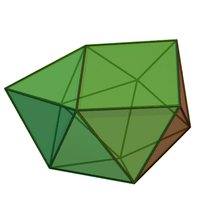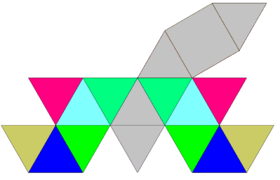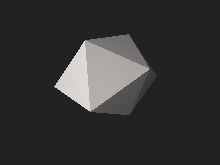Augmented sphenocorona
In geometry, the augmented sphenocorona is one of the Johnson solids (J87), and is obtained by adding a square pyramid to one of the square faces of the sphenocorona. It is the only Johnson solid arising from "cut and paste" manipulations where the components are not all prisms, antiprisms or sections of Platonic or Archimedean solids.
| Augmented sphenocorona | |
|---|---|
 | |
| Type | Johnson J86 - J87 - J88 |
| Faces | 4+6x2 triangles 1 square |
| Edges | 26 |
| Vertices | 11 |
| Vertex configuration | 1(34) 2(33.4) 3x2(35) 2(34.4) |
| Symmetry group | Cs |
| Dual polyhedron | - |
| Properties | convex |
| Net | |
 | |

A Johnson solid is one of 92 strictly convex polyhedra that is composed of regular polygon faces but are not uniform polyhedra (that is, they are not Platonic solids, Archimedean solids, prisms, or antiprisms). They were named by Norman Johnson, who first listed these polyhedra in 1966.[1]
Johnson uses the prefix spheno- to refer to a wedge-like complex formed by two adjacent lunes, a lune being a square with equilateral triangles attached on opposite sides. Likewise, the suffix -corona refers to a crownlike complex of 8 equilateral triangles. Finally, the descriptor augmented implies that another polyhedron, in this case a pyramid, is adjointed. Joining both complexes together with the pyramid results in the augmented sphenocorona.[1]
Cartesian coordinates
To calculate Cartesian coordinates for the augmented sphenocorona, one may start by calculating the coordinates of the sphenocorona. Let k ≈ 0.85273 be the smallest positive root of the quartic polynomial
Then, Cartesian coordinates of a sphenocorona with edge length 2 are given by the union of the orbits of the points
under the action of the group generated by reflections about the xz-plane and the yz-plane.[2] Calculating the centroid and the normal unit vector of one of the square faces gives the location of its last vertex as
One may then calculate the surface area of a snub square of edge length a as
and its volume as
References
- Johnson, Norman W. (1966), "Convex polyhedra with regular faces", Canadian Journal of Mathematics, 18: 169–200, doi:10.4153/cjm-1966-021-8, MR 0185507, Zbl 0132.14603.
- Timofeenko, A. V. (2009). "The non-Platonic and non-Archimedean noncomposite polyhedra". Journal of Mathematical Science. 162 (5): 718.
- Wolfram Research, Inc. (2020). "Wolfram|Alpha Knowledgebase". Champaign, IL.
Cite journal requiresPolyhedronData[{"Johnson", 87}, "SurfaceArea"]|journal=(help) - Wolfram Research, Inc. (2020). "Wolfram|Alpha Knowledgebase". Champaign, IL.
Cite journal requiresPolyhedronData[{"Johnson", 86}, "Volume"] + PolyhedronData["SquarePyramid", "Volume"]|journal=(help)